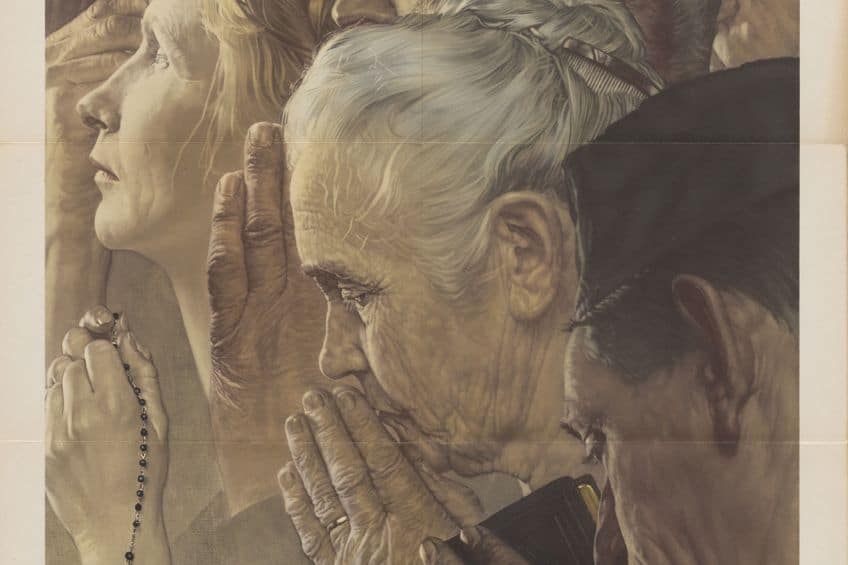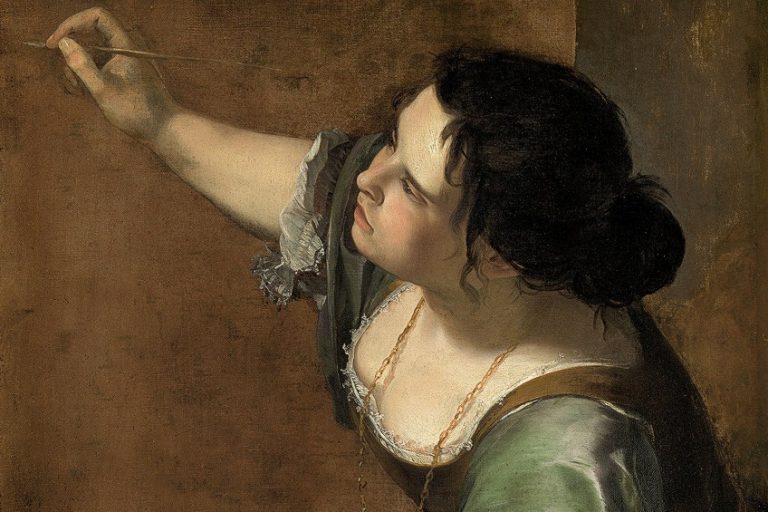“Freedom to Worship” by Norman Rockwell – An Artwork Analysis
Norman Rockwell’s Freedom to Worship is a captivating masterpiece that encapsulates the essence of religious freedom in America. Painted in 1943 during the height of World War II, Rockwell’s work reflects the nation’s values of tolerance and diversity, showcasing individuals from different walks of life gathered together in a place of worship. The painting not only celebrates the freedom to practice one’s faith but also serves as a poignant reminder of the fundamental rights enshrined in the U.S. Constitution. Through his meticulous attention to detail and emotive portrayal of the scene, Rockwell invites viewers to contemplate the significance of religious liberty in a democratic society, making Freedom to Worship a timeless and thought-provoking piece of American art.
Key Takeaways
- Rockwell’s painting emphasizes religious inclusivity and mutual respect.
- Inspired by Roosevelt’s Four Freedoms, it reflects ideals of unity.
- Continues to resonate as a symbol of tolerance and human rights.
Historical Context and Significance
| Artist | Norman Rockwell (1894 – 1978) |
|---|---|
| Date Created | 1943 |
| Medium | Oil on canvas |
| Genre | Illustration |
| Period/Movement | American Realism |
| Dimensions (cm) | 116.8 × 90 |
| Series/Versions | Part of the Four Freedoms series |
| Where Is It Housed? | Norman Rockwell Museum, Stockbridge, Massachusetts, United States |
| What It Is Worth | Estimated in the tens of millions; significant cultural and historical value |
Norman Rockwell’s Freedom to Worship stands as a powerful symbol of religious inclusivity and mutual respect. Painted in 1943, this artwork is part of Rockwell’s renowned Four Freedoms series, inspired by Franklin D. Roosevelt’s 1941 State of the Union address. The painting invites viewers to appreciate the diversity and peaceful coexistence of various faiths, reflecting an ideal of unity and respect.

The close-up perspective Rockwell uses compels viewers to intimately connect with the individuals depicted in their personal acts of worship. This detailed portrayal not only emphasizes the importance of each person’s freedom to practice their faith but also highlights Rockwell’s masterful ability to convey deep emotion and narrative through still images. Originally featured in The Saturday Evening Post and used for wartime propaganda, Freedom to Worship continues to resonate today. Its themes of tolerance and the ongoing relevance of religious freedom make this painting a timeless and poignant commentary on human rights.
Creation and Publication
Norman Rockwell created Freedom to Worship during World War II. This painting is part of a series called the Four Freedoms, inspired by President Franklin D. Roosevelt’s State of the Union Address in 1941. Roosevelt outlined essential freedoms to protect democracy: freedom of speech, freedom of worship, freedom from want, and freedom from fear. The artwork was published in The Saturday Evening Post in 1943. Rockwell’s detailed and intimate portrayal of individuals engaged in various acts of worship captured the public’s attention.
It emphasized religious freedom as a fundamental right.
Influence on American Culture
Freedom to Worship had a lasting impact on American culture. The painting reinforced the idea that the United States was a nation where diverse beliefs could coexist. It underscored the importance of tolerance and mutual respect in a democratic society. Public response was overwhelmingly positive. The artwork became a symbol of American values and aspirations, reinforcing the belief that freedom of worship is a cornerstone of democracy. The painting also played a significant role in bolstering national morale during the war years.

Impact on International Policy
The themes of Freedom to Worship transcended American borders, influencing international policies and human rights discussions. The Four Freedoms were referenced in the Atlantic Charter, an agreement between the United States and the United Kingdom during World War II, setting principles for the post-war world. These principles also influenced the formation of the United Nations. The UN’s Universal Declaration of Human Rights, adopted in 1948, echoed the essence of Roosevelt’s Four Freedoms, including freedom of worship.
Rockwell’s work, therefore, not only captured a critical period in American history but also contributed to shaping global human rights policies.
Artistic Elements and Styles
Freedom to Worship by Norman Rockwell is a profound piece that masterfully blends various artistic elements. The artwork employs a thoughtful use of color, composition, and symbolism to convey a strong narrative centered around the theme of worship and religious freedom.

Subject Matter and Color
The painting centers on diverse individuals engaged in worship, highlighting the theme of religious freedom. Rockwell uses a muted color palette to focus attention on the figures. The subtle shades and hues support the solemn and respectful tone of the scene. The mixture of different ethnicities and ages in the illustration underscores the universality of the freedom to worship.
This choice adds depth to the overall storytelling, emphasizing the inclusiveness and harmony among the worshippers.

Techniques and Composition
Rockwell employs oil on canvas to achieve depth and texture in the painting. The detailed rendering of facial expressions and clothing brings a sense of realism. He arranges the figures in a poster-like form, creating a focal point that draws the viewer’s attention to the people’s faces and hands, which express their devotion. Light and shadow are used to highlight the calm and solemn atmosphere.
The play of light on faces and hands adds to the emotional impact, making the viewers feel connected to the scene.

Symbols and Motifs
The artwork is rich with symbolism. The clasped hands, closed eyes, and peaceful expressions symbolize devotion and inner peace. Each figure represents a different religious background, symbolizing the core idea of freedom of worship. Rockwell’s attention to small details, like the prayer beads or the Bible, further reinforces the theme of diverse religious practices coexisting harmoniously. Different motifs, such as traditional attire and religious artifacts, provide deeper insight into the personal acts of worship.
These elements enhance the narrative, guiding the viewer to appreciate the significance of religious freedom on both an individual and societal level.

Themes of Religious Inclusivity
Freedom to Worship by Norman Rockwell captures a profound message of religious tolerance and respect for diverse faiths. In this painting, Rockwell combines various religious symbols and practices to emphasize the importance of freedom of religion and individual conscience. In Freedom to Worship, Rockwell includes a variety of religious figures. A Jew holding a prayer book, a Catholic with rosary beads, and a Protestant in prayer showcase the religious diversity. This gathering of different faiths symbolizes religious tolerance and acceptance. Rockwell’s choice to depict a diverse group demonstrates the respect for each person’s right to worship “each according to the dictates of his own conscience.”
This highlights the freedom of religion where all individuals can practice their beliefs without fear or prejudice.
Portrayals of Religiosity and Conscience
Rockwell’s detailed portrayal of individuals deep in prayer emphasizes personal devotion and spiritual reflection. He presents a Catholic woman gently holding rosary beads, symbolizing devotion and tradition. A Protestant man, shown with his hands clasped, signifies personal prayer without intermediaries. The act of worship displayed in the painting reflects inner peace and a commitment to one’s faith. It underscores that religious practice is a deeply personal and respected expression of conscience. By portraying this, Rockwell emphasizes that faith is a key aspect of identity and personal freedom. This artistry invites viewers to reflect on the importance of respecting and embracing different religious practices and beliefs in their communities.

Legacy and Continuing Relevance
Freedom to Worship by Norman Rockwell remains a significant piece of art. Its themes still resonate today, reflecting cultural and political values. The Norman Rockwell Museum continues to preserve this work, ensuring it remains accessible to future generations. Freedom to Worship connects profoundly to American values. Inspired by Franklin D. Roosevelt’s 1941 State of the Union Address, this painting is part of the Four Freedoms series. These themes—Freedom from Fear, Freedom from Want, Freedom of Speech, and Freedom to Worship—underscore fundamental human rights.
Rockwell’s depiction of diverse individuals in prayer promotes tolerance and unity. During World War II, this message of religious freedom was a powerful counterpoint to totalitarian regimes. Today, it continues to highlight the importance of religious tolerance in a multicultural society.
Norman Rockwell Museum and Preservation
The Norman Rockwell Museum in Stockbridge, Massachusetts, plays a crucial role in preserving Rockwell’s legacy. The museum houses many of his works, including the Four Freedoms series, making them accessible to the public. Efforts to maintain these paintings ensure their messages remain relevant. Exhibitions and educational programs by the museum expose new generations to Rockwell’s art and its historical context, underscoring its continuing impact.

Norman Rockwell’s Freedom to Worship stands as a powerful testament to the enduring values of religious freedom and unity in America. Through his masterful use of imagery and symbolism, Rockwell creates a timeless work that resonates with viewers across generations. As we reflect on the painting’s message and significance, we are reminded of the importance of upholding the principles of tolerance, diversity, and respect for individual beliefs. Freedom to Worship not only captures a moment in history but also serves as a timeless reminder of the ideals that continue to shape the fabric of American society today.
Frequently Asked Questions
What Are the Distinct Elements Depicted in Freedom to Worship by Norman Rockwell?
The painting features a group of people engaged in worship. They represent various religions and display a sense of peace and reverence.
How Does Rockwell’s Freedom to Worship Illustrate Religious Diversity?
Rockwell includes individuals of different faiths, symbolizing religious harmony. The people’s expressions and postures reflect various ways of worshiping, emphasizing acceptance.
In What Context Was Freedom to Worship by Norman Rockwell Created?
Freedom to Worship was created during World War II. It is part of the Four Freedoms series, inspired by Roosevelt’s 1941 State of the Union Address, which outlined essential human rights.
What Was Norman Rockwell’s Intention Behind the Freedom to Worship Painting?
Rockwell aimed to highlight the importance of religious freedom. The painting encourages viewers to respect and protect the diverse ways people connect with their faith.
Isabella studied at the University of Cape Town in South Africa and graduated with a Bachelor of Arts majoring in English Literature & Language and Psychology. Throughout her undergraduate years, she took Art History as an additional subject and absolutely loved it. Building on from her art history knowledge that began in high school, art has always been a particular area of fascination for her. From learning about artworks previously unknown to her, or sharpening her existing understanding of specific works, the ability to continue learning within this interesting sphere excites her greatly.
Her focal points of interest in art history encompass profiling specific artists and art movements, as it is these areas where she is able to really dig deep into the rich narrative of the art world. Additionally, she particularly enjoys exploring the different artistic styles of the 20th century, as well as the important impact that female artists have had on the development of art history.
Learn more about Isabella Meyer and the Art in Context Team.
Cite this Article
Isabella, Meyer, ““Freedom to Worship” by Norman Rockwell – An Artwork Analysis.” Art in Context. June 24, 2024. URL: https://artincontext.org/freedom-to-worship-by-norman-rockwell/
Meyer, I. (2024, 24 June). “Freedom to Worship” by Norman Rockwell – An Artwork Analysis. Art in Context. https://artincontext.org/freedom-to-worship-by-norman-rockwell/
Meyer, Isabella. ““Freedom to Worship” by Norman Rockwell – An Artwork Analysis.” Art in Context, June 24, 2024. https://artincontext.org/freedom-to-worship-by-norman-rockwell/.











